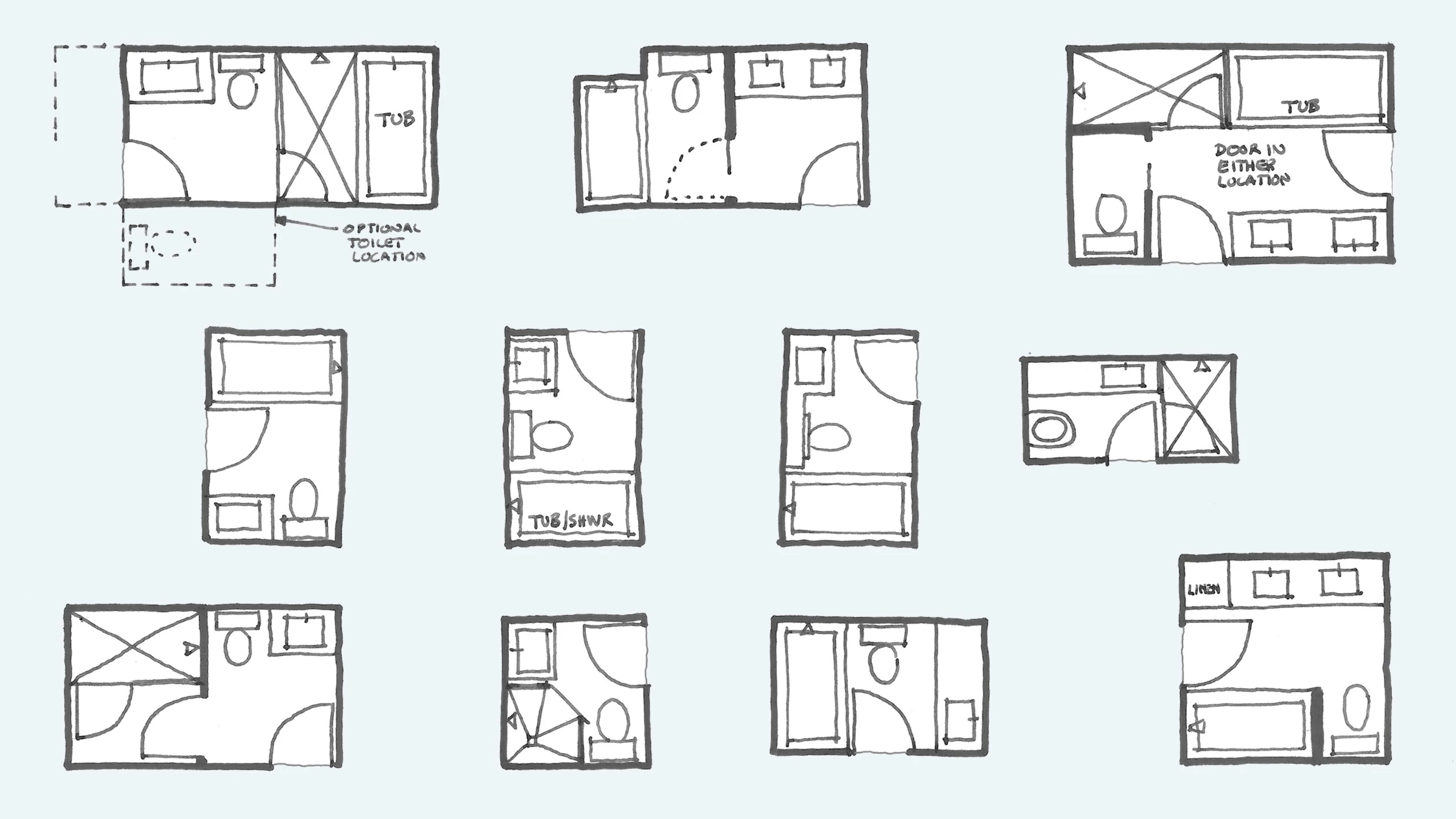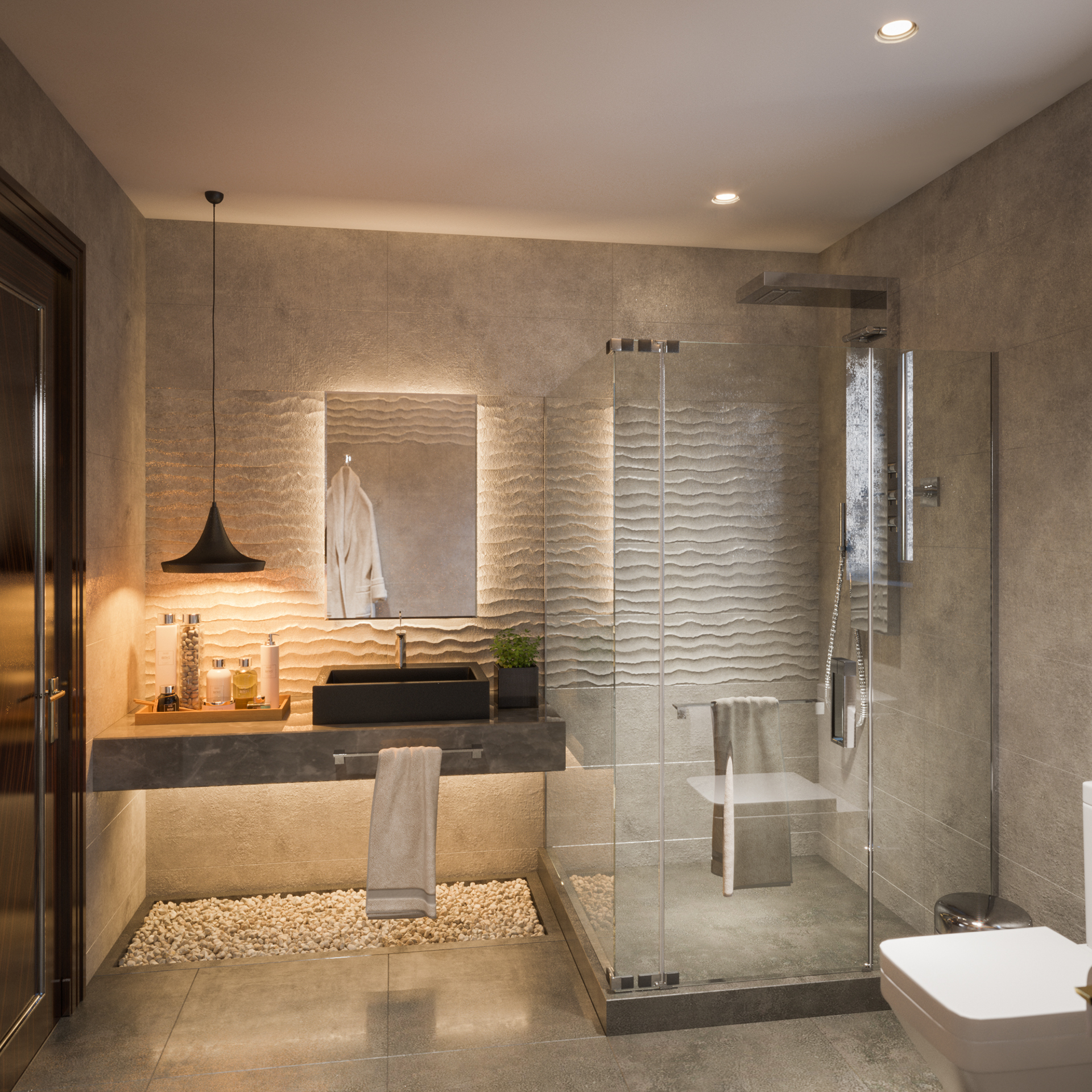Unique Flooring Materials

Unique bathroom floor ideas – Beyond the traditional choices of tile and wood, a world of unique flooring materials awaits, offering a chance to infuse your bathroom with personality and style. These materials, often overlooked, can transform your bathroom into a haven of elegance, functionality, and individuality. Let’s explore some of these unconventional options, delving into their advantages, disadvantages, and aesthetic appeal.
Unique Flooring Materials
Stepping outside the conventional realm of bathroom flooring opens up a world of possibilities. These unique materials offer a blend of aesthetics, durability, and functionality, allowing you to craft a bathroom that reflects your individual style.
- Polished Concrete: A sleek and modern option, polished concrete offers a durable, seamless surface that is resistant to water damage and stains. Its smooth, reflective finish creates a sophisticated ambiance, while its versatility allows for a range of color variations and patterns.
- Advantages: Durable, water-resistant, seamless, customizable, low maintenance.
- Disadvantages: Can be cold to the touch, may require sealing, can be susceptible to scratches.
- Epoxy Resin: This durable, waterproof material is perfect for creating a sleek, contemporary look. It can be poured seamlessly over existing surfaces, creating a smooth, non-porous floor. Epoxy resin is available in a wide range of colors and finishes, allowing for creative customization.
- Advantages: Durable, waterproof, seamless, customizable, easy to clean.
- Disadvantages: Can be expensive, requires professional installation, can be slippery when wet.
- Reclaimed Wood: Bringing a touch of rustic charm to your bathroom, reclaimed wood adds warmth and character. Its unique grain patterns and natural variations create a visually appealing and sustainable flooring option.
- Advantages: Eco-friendly, unique character, warm and inviting, adds rustic charm.
- Disadvantages: Requires proper sealing and maintenance, can be susceptible to water damage, may be more expensive than other options.
- Natural Stone: From elegant marble to rugged slate, natural stone brings a touch of luxury and sophistication to your bathroom. Its natural beauty and durability make it a popular choice for both floors and walls.
- Advantages: Durable, water-resistant, naturally beautiful, adds a touch of luxury.
- Disadvantages: Can be expensive, requires sealing, may be cold to the touch, can be slippery when wet.
- Cork: This eco-friendly material offers a warm, soft feel underfoot. Cork is naturally waterproof and antimicrobial, making it a hygienic and sustainable choice for bathrooms.
- Advantages: Eco-friendly, soft and comfortable, naturally waterproof, antimicrobial.
- Disadvantages: Can be susceptible to scratches and dents, may not be as durable as other options.
- Bamboo: A sustainable and renewable resource, bamboo flooring adds a touch of natural elegance to your bathroom. It is known for its durability and resistance to moisture.
- Advantages: Sustainable, durable, water-resistant, adds a touch of natural elegance.
- Disadvantages: Can be more expensive than other options, may require specialized installation.
- Slate: A durable and versatile option, slate flooring brings a rustic and elegant touch to your bathroom. Its natural variations in color and texture create a unique and visually appealing surface.
- Advantages: Durable, water-resistant, naturally beautiful, adds a rustic and elegant touch.
- Disadvantages: Can be slippery when wet, requires sealing, may be cold to the touch.
- Terrazzo: This composite material, made from chips of marble, granite, or other materials set in a binder, offers a unique and durable flooring option. Terrazzo can be customized with a variety of colors and patterns, creating a unique and eye-catching floor.
- Advantages: Durable, water-resistant, customizable, adds a touch of vintage charm.
- Disadvantages: Can be expensive, requires professional installation, may be cold to the touch.
Geometric and Patterned Designs: Unique Bathroom Floor Ideas
Geometric patterns in bathroom flooring add a unique and stylish touch, transforming the space into a visually captivating sanctuary. From classic to contemporary, geometric designs offer endless possibilities for creating a personalized and functional bathroom environment.
Geometric Patterns and Their Impact on Bathroom Ambiance
Geometric patterns can significantly influence the overall feel and ambiance of a bathroom. For instance, using a bold geometric pattern, such as a large-scale chevron or a honeycomb design, can create a dramatic and modern statement, adding visual interest and depth to the space. On the other hand, incorporating subtle geometric patterns, like small-scale squares or triangles, can contribute to a more understated and refined aesthetic, enhancing the bathroom’s sense of tranquility and elegance.
Design Options with Geometric Patterns, Unique bathroom floor ideas
Geometric patterns can be achieved using various tile shapes and sizes, offering diverse design options for bathroom floors.
- Classic Geometric Patterns:
These patterns are timeless and versatile, easily adapting to various bathroom styles.
- Checkerboard: This classic pattern uses two contrasting colors, often black and white, to create a visually stimulating and timeless design. It can be achieved using square tiles of equal size, arranged in an alternating pattern.
- Herringbone: This pattern, characterized by its distinctive V-shaped arrangement of tiles, adds a touch of sophistication and elegance to the bathroom. It can be created using rectangular tiles, laid in a staggered pattern to form a continuous zigzag design.
- Basketweave: This intricate pattern features rectangular tiles woven together to create a basket-like texture. It adds visual interest and depth to the bathroom floor, enhancing its overall appeal.
- Contemporary Geometric Patterns:
These patterns reflect modern design trends, often incorporating bold colors and intricate designs.
- Chevron: This pattern, characterized by its distinctive V-shaped design, adds a contemporary and dynamic feel to the bathroom. It can be created using rectangular tiles, laid in a staggered pattern to form a continuous chevron design.
- Honeycomb: This pattern, inspired by the structure of a honeycomb, creates a visually captivating and modern design. It can be achieved using hexagonal tiles, arranged in a close-packed pattern to create a unique and eye-catching effect.
- Starburst: This pattern, characterized by its radiating design, adds a touch of dynamism and excitement to the bathroom. It can be created using various tile shapes, such as squares or triangles, arranged in a radial pattern to create a starburst effect.
Color Combinations for Geometric Patterns
Choosing the right color combination is crucial in creating a harmonious and visually appealing bathroom floor design.
- Monochromatic: This approach uses different shades of the same color, creating a sense of unity and sophistication. For example, using various shades of gray, from light to dark, can create a calming and elegant bathroom floor.
- Complementary: This approach uses colors that are opposite each other on the color wheel, creating a high-contrast and visually stimulating design. For example, using blue and orange or green and red can create a bold and dynamic bathroom floor.
- Analogous: This approach uses colors that are adjacent to each other on the color wheel, creating a harmonious and cohesive design. For example, using shades of blue, green, and purple can create a serene and tranquil bathroom floor.
Bold vs. Subtle Geometric Patterns
The choice between bold and subtle geometric patterns depends on the desired aesthetic and the size of the bathroom.
- Bold Geometric Patterns:
Bold geometric patterns can create a dramatic and modern statement, adding visual interest and depth to the space. They are particularly well-suited for larger bathrooms, where they can be used to define areas or create a focal point.
- Subtle Geometric Patterns:
Subtle geometric patterns, on the other hand, can contribute to a more understated and refined aesthetic, enhancing the bathroom’s sense of tranquility and elegance. They are ideal for smaller bathrooms, where they can help create a sense of spaciousness without overwhelming the space.
Texture and Dimension

Adding texture and dimension to a bathroom floor can transform it from a simple surface to a captivating design element. It enhances the overall aesthetic, adds tactile interest, and can even improve functionality.
Creating Texture and Dimension
Texture and dimension can be achieved through various materials and techniques. Here are some popular options:
- Raised Tiles: Tiles with raised patterns, like embossed or textured tiles, create a tactile experience and add visual interest. These tiles can be used in various styles, from traditional to modern.
- Mosaic Patterns: Mosaic tiles, with their small size and intricate patterns, offer endless possibilities for creating textured and dimensional surfaces. They can be arranged in geometric shapes, organic patterns, or even abstract designs.
- Textured Finishes: Concrete, epoxy, and other flooring materials can be treated with textured finishes to create a unique look and feel. These finishes can mimic natural materials like stone or wood, or create abstract patterns.
Examples of Textured Bathroom Floors
- Stone Tile with Embossed Patterns: A bathroom floor with large stone tiles featuring subtle embossed patterns adds a touch of elegance and dimension. The raised patterns provide tactile interest, and the natural stone adds a timeless quality.
- Mosaic Tile in a Geometric Pattern: A bathroom floor with mosaic tiles arranged in a geometric pattern creates a visually stimulating and textured surface. The small tiles and intricate design add a sense of depth and complexity.
- Textured Concrete Floor: A bathroom floor with textured concrete, resembling natural stone or wood, provides a modern and industrial aesthetic. The textured surface adds visual interest and can be customized with different colors and patterns.
Benefits of Texture and Dimension
Texture and dimension on a bathroom floor offer numerous benefits:
- Visual Interest: Texture and dimension break up the monotony of a flat surface, adding visual interest and depth to the bathroom.
- Tactile Experience: Textured floors provide a more engaging and tactile experience, enhancing the overall sensory appeal of the bathroom.
- Enhanced Functionality: Textured surfaces can improve safety by providing better traction, especially in wet areas. They can also help to mask imperfections in the subfloor.
